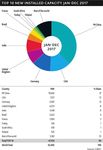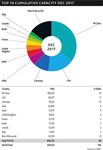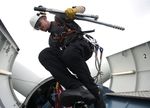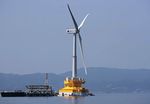Global wind power: 2017 market and outlook to 2022 - PES
←
→
Page content transcription
If your browser does not render page correctly, please read the page content below
PES ESSENTIAL
Global wind power: 2017
market and outlook to 2022
PES asked Steve Sawyer, Secretary General at GWEC for his record investment of USD 348.5bn (EUR
324.6bn) in 2015. According to BNEF,
outlook on the future of the wind industry markets. Will prices China alone accounted for 40% of total
investment with US$ 133bn (EUR 118.7bn);
continue to fall or have they reached their lowest point? Where and the Asia Pacific region as a whole
is the market increasing? Where is it slowing down? Read on invested US$ 187 billion, over 57% of the
total. Total investment in wind amounted
and find out… to 107 billion US$. 2
Cratering prices for both onshore and
The global wind power market remained increase on the 2016 market, bringing total offshore wind continue to surprise. Markets
above 50 GW in 2017, with Europe, India global installations to 18,814 MW, and in such diverse locations as Morocco, India,
and the offshore sector all having record representing a 30% increase in cumulative Mexico, Brazil and Canada range in the
years. Chinese installations were down - capacity globally. Offshore was about 8.4% area of US$ 0.03/kWh, with a recent
19.66 GW - but the rest of the world made of the 2017 annual market, and represents Mexican tender coming in with prices below
up for most of that. Total installations in about 3.5% of cumulative installed US$ 0.02. I think we can safely consign the
2017 were 52,492 MW, bringing the global capacity, but it’s growing quickly. phrase ‘renewables are too expensive’ to
total to 539,123 MW. The annual market the dustbin of history.
Total new investment in clean energy rose
was in fact down 3.8% on 2016’s 54,642
to US$ 333.5bn (€296.8bn1) in 2017, up Meanwhile, offshore wind had its first
MW; and the cumulative total is up 11%
3% over 2016, but still lower than the
over 2016’s year-end total of 487,219 MW.
2 https://data.bloomberglp.com/bnef/
The offshore segment had a record year 1 Exchange rate used for USD to EUR conversion sites/14/2018/01/BNEF-Clean-Energy-Investment-
with 4,331 MW of installations, an 87% (USD1 = EUR 0.89) Investment-Trends-2017.pdf
1 PES WindPES ESSENTIAL
‘subsidy-free’ tender in Germany last year,
with tenders for more than 1 GW of new
offshore capacity receiving no more than
the wholesale price of electricity. A Dutch
‘subsidy-free’ offshore tender in early 2018
followed suit. While it will be some years
before this is the new normal, offshore
going forward is economically competitive
with any and all new forms of generation, at
least in Europe; offshore prices for projects
to be completed in the next 5 years are half
of what they were for the last five years; and
this has sparked huge interest in the
technology around the globe: in the United
States, Japan, South Korea, Taiwan, India, sophisticated market structures for By the end of 2017 there were 30 countries
Australia and even Brazil! matching up supply and demand at all with more than 1,000 MW installed: 18 in
2017 was not a spectacular year in terms of scales are just some of the elements Europe; 5 in Asia-Pacific (China, India,
global installations, but key developments beginning to emerge. Japan, South Korea & Australia); 3 in North
marked the forward progress of the energy America (Canada, Mexico, US), 3 in Latin
China, the largest overall market for wind America (Brazil, Chile, Uruguay) and 1 in
transformation. Driven by the improving
power since 2009, retained the top spot in Africa (South Africa). Nine countries have
economics of wind power, as well as solar
2017. In 2017, wind power produced 305.7 more than 10,000 MW of installed capacity:
and storage, the outlines of a future
TWh, an increase of more than 26% China, the US, Germany, India, Spain, the
sustainable energy system are beginning to
compared with 2016, and accounts for about UK, France, Brazil and Canada.
become clear.
4.75% of total Chinese power generation.3
‘Hybrid’ wind/solar/storage plants are now China will cross the 200,000 MW mark in
Installations in Asia once again led global 2018, adding another milestone to its
being built, able to supply clean reliable
power 24/7 for much of the year; utilities are markets, with Europe in the second spot, already exceptional history of renewable
seriously experimenting with battery and North America in third. Once again in energy development since 2005.
storage in place of peaker plants; and EV 2017, as has been the case since 2010
(except 2012), the majority of wind Looking ahead
sales are booming in key markets. The
development of local micro-grids, some installations globally were outside the OECD. The aftermath of the global financial crisis
using peer to peer power trading with 3 https://chinaenergyportal.org/en/2017-electrici- in the previous decade resulted in average
blockchain technology, and more and more ty-energy-statistics/ global markets of about 40 GW/annum for
www.peswind.com 2PES ESSENTIAL
the period from 2009 to 2013. Breaking grow, albeit at a slower pace, in the and fewer markets. North America looks
through the 50 GW barrier for the first beginning of the new decade. We expect pretty stable for the next few years, and
time in 2014, the industry set a record of to see total cumulative installations reach we’re expecting Mexico to start to fulfil its
more than 60 GW due to anomalously 840 GW by the end of 2022. promise in 2018.
high installations in China in 2015. In 2016
The Asia market continues to dominate Despite the fact that Brazil’s political and
the market returned to the ‘new normal’ of
and will do so for the foreseeable future. economic woes have abated somewhat, we
just over 54 GW, and 2017 was in the
While China continues to be by far the will feel the effect of the lack of auctions for
same range.
largest market globally, the days of most of the last two years over the next
What does all this mean for wind markets dramatic year-on-year annual market three years. Argentina is one of the
in 2018-2022? We expect the annual increase are probably over, at least for the brightest spots in the wind universe at the
market to remain at roughly 2017’s level for next few years. India will play a much moment, and Chile will continue to grow, as
2018 due to anticipated decreases in stronger role, although the 2018 market will some of the smaller Latin American
Germany, the UK and India. This will be will disappoint. Europe is unlikely to repeat markets. The South African hiatus is over,
balanced by increases in North America, the record installation levels of 2017, but and there should also be significant
the Middle East and Africa and Latin we’ve been looking for a downturn in installations in North Africa in the coming
America. The annual market will return to Europe for the last five years at least, and years. Australia will continue to be the only
growth in 2019 and 2020, breaching the 60 it hasn’t come yet, although there has significant market in the Pacific for the
GW barrier once again and continue to been a worrying concentration in fewer coming years as the fulfilment of the
Mandatory Renewable Energy Target
proceeds apace.
Will there be unforeseen surprises?
Probably. Will Russia and Saudi Arabia
finally begin to reach their potential and
provide rapidly growing major new markets
for the industry? Perhaps. What about the
Vietnam, the Philippines and the rest of the
Southeast Asia? The only thing that we can
say for certain is that the increase in the
rate of change in energy markets will
continue to accelerate in the coming years.
Wind power is increasingly the most
competitive way of adding new power
generation to the grid in an increasing
number of markets, even competing
against heavily subsidized incumbents;
and for the first time we can say that this
now includes offshore.
Wind is a mature technology, with proven
reliability and cost competitiveness. It is
both more and more often the technology
of choice for utilities, and has also
dominated the surging corporate PPA
market, where savvy companies look to
3 PES WindPES ESSENTIAL
both provide a hedge against potentially are solid signs that it will in 2018, but we charge in the transition away from fossil
wildly fluctuating fossil prices, and at the shall see. fuels; and continues to blow away the
same time reduce their carbon footprint – There is a still an acute need around the competition on price, performance
not to mention ‘greening’ their image with world for new power generation, which is and reliability.
increasingly vigilant consumers. clean, affordable, indigenous, reliable and
quick to install. Wind power is leading the www.gwec.net
Wind is making a rapid transition from a
technology reliant on ‘support’ in most
markets, to one where it stands on its own
economically, even without any kind of
financial benefit for the major rewards
society reaps from its deployment in
terms of clean air and carbon-dioxide
emissions reductions. Hopefully we’ll get
there one day. But in the meantime, the
industry will have to struggle with shifting
policy regimes and the inevitable gaps
that accompany them and do our best to
take it to the next level – annual
installations of 60, 70, or even 100 GW/
year. This will be necessary to meet the
Paris targets and secure a sustainable
energy future on a planet left habitable for
succeeding generations.
2017 saw a concentration of installations in
a smaller number of markets in Europe,
Africa, and Latin America, reversing a trend
for a diversification of markets that has
marked the industry’s growth over the last
decade. That needs to change, and there
www.peswind.com 4You can also read


























































